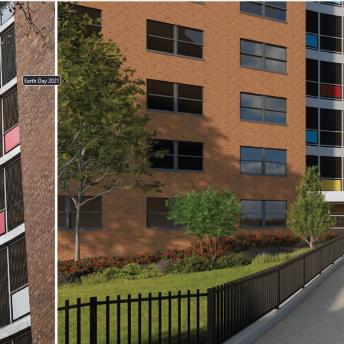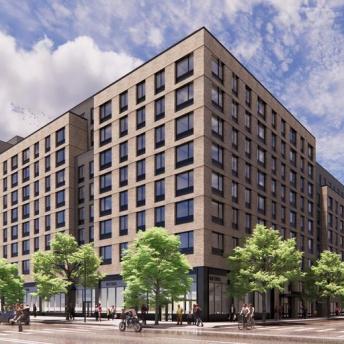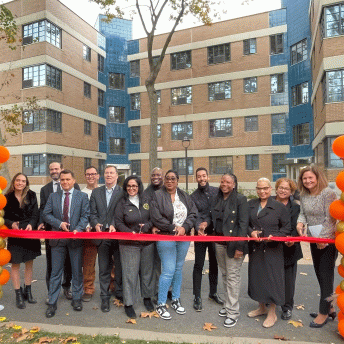Bronx, New York – The New York City Department of Housing Preservation and Development (HPD) and the New York City Housing Development Corporation (HDC) joined Workforce Housing Group, (WHG) Winn Residential and development partners for the ceremonial ribbon-cutting celebration for Creston Avenue Apartments, a four building project with a combined total of 122 apartments in the University Heights neighborhood of the Bronx. During his time as Public Advocate, Mayor de Blasio highlighted the buildings on his ‘worst landlords’ list. Before WFH took ownership, the buildings were also selected for HPD’s Alternative Enforcement Program (AEP), an initiative that annually targets the 200 most distressed buildings in the City for remediation. Today, officials join residents to celebrate the completion of substantial rehabilitation and the preservation of affordability for all four buildings.
“After years of severe hardships, residents of these four Creston Avenue buildings can feel safe and secure in their own homes. I am delighted to join with tenants and their new landlord to celebrate the successful completion of this long-overdue, new beginning on Creston Avenue,” said HPD Commissioner Vicki Been. “I would like to thank developer Workforce Housing Advisors and all of our partners for putting these families first and giving them the quality homes they so deserve – and my staff for their dogged determination to get financing in place that will ensure these homes remain affordable for low-income families in the Bronx for decades to come.”
“Today we celebrate not only the rehabilitation of housing but the renewal of opportunity”, said Gary Rodney, President of HDC. “The substantial renovation of the four buildings in the Creston Avenue portfolio demonstrates The City’s commitment to strengthen neighborhoods and improve lives through strategic preservation investments and initiatives. I commend the Creston Avenue residents, our partners at Workforce Housing, our colleagues at HPD, and the elected officials whose combined leadership and efforts made this project possible. And I thank all our public and private partners for their ongoing support as we continue working together to make New York the more affordable and equitable city envisioned by Mayor Bill de Blasio.”
“The complete rehabilitation of these 122 units on Creston Avenue speaks volumes to the tenacity of the tenants of these three buildings who fought back an unscrupulous landlord who purposefully allowed their homes to badly deteriorate over the years,” said State Senator Gustavo Rivera. “I also commend the work of the public and private partners involved in this project for investing in our community to protect our existing affordable housing stock, while making our neighborhood a safer place to live. This is a great example of what we can accomplish when we work together.”
By the time WHFA took title to the four Creston Avenue buildings in April 2012, the previous ownership had allowed the properties to accrue over 1,000 hazardous and immediately hazardous housing code violations requiring all four buildings to be placed in AEP. Absent AEP, the properties would have continued to rapidly deteriorate and pose a health and safety risk to the tenants and may have threatened the stability and integrity of the surrounding neighborhood. The AEP allowed HPD to target these properties, do roof-to-cellar inspections, order the replacement of major buildings systems, and perform more than $40,000 in emergency repairs to the most hazardous conditions which the former owners refused to address.
“The Creston Avenue buildings and tenants suffered tremendously from speculator landlords who tore the community apart.” Said John A. Crotty partner Workforce Housing Group. “ We are very pleased to have worked with HDC, HPD, the City Council, JP Morgan Chase and Morgan Stanley to develop and implement a turnaround plan that restored the buildings to excellent physical condition so that, together we the tenants, we can reweave the fabric of community.”
“Tenants in these buildings suffered for years due to owners who speculate on the value of their homes and seek unreasonable profits at the expense of decent living conditions. When the residents at 2239 & 2241 Creston Ave began organizing, their homes were in foreclosure and the already poor conditions began declining rapidly. We have seen this pattern transpire across the city where financial recklessness has led to massive deterioration and tenant harassment causing harm to low income families. This deal demonstrates the only way to remove buildings from the cycle of predatory lending on distressed housing: to implement a plan that includes the intensive repairs the buildings need, while ensuring that the future debt will be sustainable at rents the tenants can afford. We are grateful to Workforce Housing Group and the city agencies for their support of the tenants in these buildings and hope this can serve as a model to preserve and protect low income residents across New York City,” said Kerri White Director of Organizing and Policy, UHAB
Under the ownership of WHG, the Creston Avenue buildings underwent substantial rehabilitation. The five-story walk-up multifamily apartment buildings were originally constructed between 1915 and 1927. The renovation of 2239, 2241, 2323, and 2333 Creston Avenue included major structural upgrades such as significant beam replacement, the installation of new kitchens and bathrooms, new roofs, and new windows. All major systems were replaced and upgraded; this includes new electrical systems, new security systems, new plumbing systems, new heating plants and distribution systems. The buildings were also outfitted to meet Enterprise Green Community Standards, and feature low emission windows, the use of low VOC paints, Energy Star Appliances and light fixtures, and low flow plumbing fixtures.
WHG and development partners documented the residents’ stories during rehabilitation through a Ghetto Film School video production. Visit the following link to learn more about their individual stories: Creston Ave, Bronx NY. Four buildings start second life as long term affordable housing
Creston Ave, Bronx NY. Four buildings start second life as long term affordable housing
The four buildings have a combined total of 122 apartments that include 11 studios, 56 one-bedroom, 39 two-bedroom, 14 three-bedroom apartments and 2 superintendent’s units. All units are affordable to low-income families earning a maximum annual income within the range of $36,300 to $46,620. Income levels are set according to the U.S. Department of Housing and Urban Development (HUD) 2015 calculations. Winn Residential serves as the managing agent for this development.
“At National Equity Fund, we believe that extraordinary things can happen with great partners and this ribbon cutting ceremony proves that belief to be true,” commented Joseph S. Hagan, President and CEO of NEF. “Creston Avenue will provide safe, sustainable and affordable housing as well as infuse the area with a sense of community.”
“Morgan Stanley is proud to have been part of the financing at Creston Avenue at multiple stages on its road from distress to renewal. We applaud the City, Workforce Housing and all of our financing partners,” said Roy Swan, Managing Director in Morgan Stanley Global Sustainable Finance.
The total development cost for the preservation of the four Creston Avenue buildings is approximately $28.6 million. Funding sources included $14.2 million in construction financing through tax-exempt bonds from HDC with credit enhancement from JPMorgan Chase and Morgan Stanley. HPD provided $10.8 million on permanent financing through 421a Funds. HPD also allocated Low-Income Housing Tax Credits to the project, underwritten by The National Equity Fund (NEF) with Morgan Stanley as investor. The New York City Council provided $1.5 million in Reso A funds. HPD and the City Council also worked to facilitate an Article XI tax exemption. The tax exemption will help diminish long-term costs and therefore help subsidize the long-term affordability of the low-income apartments.
###
About the New York City Department of Housing Preservation and Development (HPD):
The New York City Department of Housing Preservation and Development (HPD) is the nation’s largest municipal housing preservation and development agency. Its mission is to promote quality housing and diverse, thriving neighborhoods for New Yorkers through loan and development programs for new affordable housing, preservation of the affordability of the existing housing stock, enforcement of housing quality standards, and educational programs for tenants and building owners. HPD is tasked with fulfilling Mayor de Blasio’s Housing New York: A Five-Borough Ten-Year Plan to create and preserve 200,000 affordable units for New Yorkers at the very lowest incomes to those in the middle class. For more information visit www.nyc.gov/hpd and for regular updates on HPD news and services, connect with us via www.facebook.com/nychpd and www.twitter.com/nychousing.
About the New York City Housing Development Corporation (HDC):
HDC is the nation’s largest municipal Housing Finance Agency and is charged with helping to finance the creation or preservation of affordable housing under Mayor Bill de Blasio’s Housing New York plan. Since 2003, HDC has financed more than 120,000 housing units using over $13.7 billion in bonds, and provided in excess of $1.6 billion in subsidy from corporate reserves. HDC has been the #1 issuer in the nation of mortgage revenue bonds for affordable multi-family housing in each of the last three years. In Affordable Housing Finance Magazine’s most recently published annual listing of the nation’s top ten funders of multi-family housing, HDC is the only municipal entity on the list. HDC is also the third largest affordable housing lender in the U.S. after Citi and Wells Fargo, ranking ahead of such industry leaders as Bank of America and Capital One. For additional information, visit: www.nychdc.com.
Workforce Housing Group:
Workforce Housing Group (formerly Workforce Housing Advisors) operates at the forefront of the multi-family real estate market in the New York metropolitan area by repositioning distressed assets as affordable housing resources. We work collaboratively with for-profit, not-for-profit and government partners to execute redevelopment plans for properties that had previously been subject to financial and physical distress.
Urban Homesteading Assistance Board (UHAB):
UHAB is a non-profit organization which provides low-income residents with the training and support services they need to sustain their homes with an emphasis on using the self-help housing process as a catalyst for leadership development and broader community change. The majority over our 40 year history has focused on creating and preserving over 30,000 units of high quality housing co-operatives throughout New York City. UHAB’s Organizing and Policy department focuses on empowering residents in rent regulated and subsidized buildings to create tenant associations to advocate for the protection of affordability, to fight for safe, decent living conditions, and to foster preservation-friendly policy changes at the local, state, and national level.


